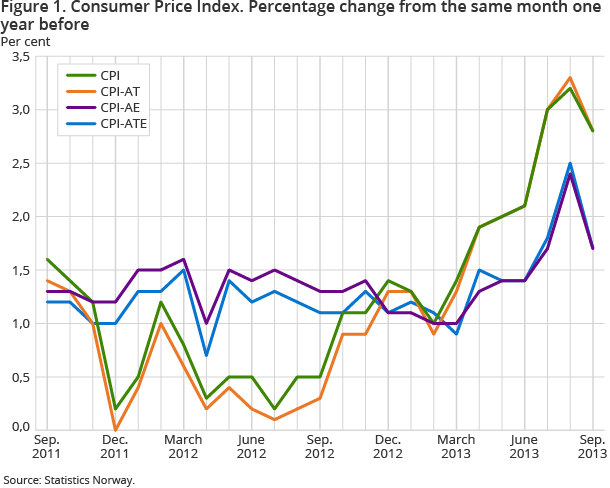Content
Published:
This is an archived release.
CPI up 2.8 per cent in last twelve months
The Consumer Price Index (CPI) rose by 0.5 per cent from August to September, mainly due to a price increase in furniture and clothing. The year-to-year growth in the CPI was 2.8 per cent in September, while the CPI-ATE increased 1.7 per cent in the same period.
| Monthly change (per cent) | 12-month rate (per cent) | Index | |
|---|---|---|---|
| August 2013 - September 2013 | September 2012 - September 2013 | September 2013 | |
| CPI All-item index | 0.5 | 2.8 | 134.9 |
| Food and non-alcoholic beverages | -0.2 | 1.7 | 126.9 |
| Housing, water, electricity, gas and other fuels | 0.7 | 8.3 | 166.5 |
| Transport | 0.0 | 0.8 | 146.8 |
| Recreation and culture | -0.3 | 1.1 | 117.0 |
| Clothing and footwear | 3.4 | -3.2 | 54.2 |
| CPI-ATE (july 1999 = 100) | 0.4 | 1.7 | 125.4 |
| CPI by delivery sector | |||
| Other consumer goods produced in Norway | 0.9 | 9.0 | 162.7 |
| Imported consumer goods | 0.9 | -0.4 | 89.9 |
| Other services with wages as dominating price factor | 0.5 | 3.5 | 203.8 |

The CPI was 134.9 (1998=100) in September 2013, compared to 131.2 in the same month the year before.
Monthly change: rise in furniture and clothing prices
From August to September, the CPI rose by 0.5 per cent. The seasonal contribution of furniture and clothing made a particular contribution to the recovery in September. The group furniture, carpets etc. showed a price increase of 8.6 per cent in September, largely due to discount activity in August. Every category within clothing experienced higher prices, which led to a 3.7 per cent rise in clothing prices.
It was mainly books that pulled the CPI in the opposite direction. From August to September book prices fell 8.4 per cent.
Year-to-year growth: strong growth in electricity prices
The CPI rose by 2.8 per cent from September 2012 to September 2013. The main contributor to the year-to-year growth was the 33.7 per cent increase in prices of electricity including grid rent. In September this year, electricity prices including grid rent were slightly above the average level of the last ten years, while the level in September last year was well below the average in this period. This explains the high year-to-year growth for electricity prices including grid rent.
Other important contributors to the growth in the CPI in the last twelve months were, among other factors, imputed rentals for home owners, which rose by 3.8 per cent. Prices of alcoholic beverages and tobacco were 4.5 per cent above the September 2012 level. In the same period, restaurants showed a price increase of 3.0 per cent.
The main contributor to dampening the increase in the CPI in the last twelve months was a price fall for clothing of 4.0 per cent. An 8.6 per cent price decline was also measured for airfares.
Change in the year-to-year growth: CPI and CPI-ATE down
The year-to-year growth in the CPI fell from 3.2 per cent in August to 2.8 per cent in September. The main contributor was the price development in clothing. Clothing prices rose 3.7 per cent from August to September this year, while a price increase of 8.8 per cent was measured in the same period last year. The development of food prices also affected the drop in the year-to-year growth. The price development of the two consumption groups airfares and fuels and lubricants for personal transport equipment also contributed to dampen the year-to-year growth.
Electricity prices including grid rent rose 2.7 per cent from August to September this year, while falling 1.2 per cent in the same period last year. This, together with the price development in furniture and imputed rentals for home owners, contributed to dampen the fall in the year-to-year growth in the CPI.
The year-to year growth in the CPI adjusted for tax changes and excluding energy products (CPI-ATE) was 1.7 per cent in September; down 0.8 percentage points from 2.5 per cent the previous month. This is largely due to the price development of clothing, food and airfares as mentioned above.
More about the change in the year-to-year growthOpen and readClose
The year-to-year growth provides a picture of the development between last month’s index and the index for the same month the previous year. Since the index rolls over 12 months, both the price change from, for example, August to September the year before, and the price change between the same months this year affect the change in the year-to-year growth.
The year-to-year growth in CPI-ATE has shown fluctuations in the last two months, from 1.8 per cent in July to 2.5 per cent in August, and down to 1.7 per cent in September. This can be explained by the different price paths for airfares, clothing and food viewed in comparison with the same month the year before.
Contact
-
Statistics Norway's Information Centre
E-mail: informasjon@ssb.no
tel.: (+47) 21 09 46 42
-
Konsumprisindeksen
E-mail: konsumprisindeksen@ssb.no
tel.: (+47) 62 88 56 34
-
Camilla Rochlenge
E-mail: camilla.rochlenge@ssb.no
tel.: (+47) 40 90 23 72
-
Kjersti Nyborg Hov
E-mail: kjersti.nyborg.hov@ssb.no
tel.: (+47) 40 90 23 63
-
Gunnar Larsson
E-mail: gunnar.larsson@ssb.no
tel.: (+47) 40 90 26 79
-
Trym Kristian Økland
E-mail: trym.okland@ssb.no
tel.: (+47) 46 81 09 15
